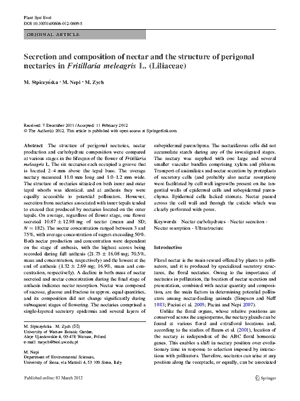NEWS 2012
Secretion and composition of nectar and the structure of perigonal nectaries in Fritillaria meleagris L. (Liliaceae)
M. STPICZYŃSKA¹, M. NEPI², M. ZYCH¹
Plant Systematics Evolution 298(5): 997-1013 (2012)
doi: 10.1007/s00606-012-0609-5
¹University of Warsaw Botanic Garden, Aleje Ujazdowskie 4, 00-478 Warsaw, Poland [mzych@biol.uw.edu.pl]
²Department of Environmental Sciences, University of Siena, via Mattioli 4, 53 100 Siena, Italy
Abstract
The structure of perigonal nectaries, nectar production and carbohydrate composition were compared at various stages in the lifespan of the flower of Fritillaria meleagris L. The six nectaries each occupied a groove that is located 2–4 mm above the tepal base. The average nectary measured 11.0 mm long and 1.0–1.2 mm wide. The structure of nectaries situated on both inner and outer tepal whorls was identical, and at anthesis they were equally accessible to potential pollinators. However, secretion from nectaries associated with inner tepals tended to exceed that produced by nectaries located on the outer tepals. On average, regardless of flower stage, one flower secreted 10.87 ± 12.98 mg of nectar (mean and SD; N = 182). The nectar concentration ranged between 3 and 75%, with average concentration of sugars exceeding 50%. Both nectar production and concentration were dependent on the stage of anthesis, with the highest scores being recorded during full anthesis (21.75 ± 16.08 mg; 70.5%, mass and concentration, respectively) and the lowest at the end of anthesis (1.32 ± 2.69 mg; 16.9%, mass and concentration, respectively). A decline in both mass of nectar secreted and nectar concentration during the final stage of anthesis indicates nectar resorption. Nectar was composed of sucrose, glucose and fructose in approx. equal quantities, and its composition did not change significantly during subsequent stages of flowering. The nectaries comprised a single-layered secretory epidermis and several layers of subepidermal parenchyma. The nectariferous cells did not accumulate starch during any of the investigated stages. The nectary was supplied with one large and several smaller vascular bundles comprising xylem and phloem. Transport of assimilates and nectar secretion by protoplasts of secretory cells (and probably also nectar resorption) were facilitated by cell wall ingrowths present on the tangential walls of epidermal cells and subepidermal parenchyma. Epidermal cells lacked stomata. Nectar passed across the cell wall and through the cuticle which was clearly perforated with pores.

